The Netherlands is a kingdom that loves parades! Lewis and I do, too.
It keeps its long heritage alive.
The Dutch also love their monarchy.
In the seventh year of his reign, the 53-year-old King of the Netherlands is beloved by his people...
...and he is the titular Head of State and Dutch Armed Forces.
Prince’s Day is an annual celebration in the Netherlands—one of only three kingdoms that still observes the tradition of having a Throne Speech. The British call theirs the State Opening of Parliament. For the Dutch, it occurs on the third Tuesday of September, and His Majesty's Throne Speech is broadcast around the globe.
If the King and Queen preside at the event, you might wonder why is it called Prince's Day? Here's the reason. It began in 1384 when the Dutch appointed their own leader, who was titled a stadtholder. The role was similar to an elected governor of the land. At that time, the Netherlands was a republic. In 1544, an 11-year-old Dutchman named Willem, Count of Nassau, was made the Prince of Orange because he inherited a principality named Orange. It was in the beautiful Côte d'Azur region, in the southern part of France.
The territory was founded by an ancient Celtic culture who defended it against the Roman Empire in 105 BC. In 35 BC, the Romans conquered and improved it. After the Carolingian Renaissance of the High Middle Ages, it was upgraded to a principality in 1163. As a 12th-century fiefdom of the Holy Roman Empire, it encompassed 20 towns; many remain.
*Since 1180, there were 16 Princes of Orange with "Willem" in their names, including the current king.
...and he is the titular Head of State and Dutch Armed Forces.
Prince’s Day is an annual celebration in the Netherlands—one of only three kingdoms that still observes the tradition of having a Throne Speech. The British call theirs the State Opening of Parliament. For the Dutch, it occurs on the third Tuesday of September, and His Majesty's Throne Speech is broadcast around the globe.
If the King and Queen preside at the event, you might wonder why is it called Prince's Day? Here's the reason. It began in 1384 when the Dutch appointed their own leader, who was titled a stadtholder. The role was similar to an elected governor of the land. At that time, the Netherlands was a republic. In 1544, an 11-year-old Dutchman named Willem, Count of Nassau, was made the Prince of Orange because he inherited a principality named Orange. It was in the beautiful Côte d'Azur region, in the southern part of France.
The territory was founded by an ancient Celtic culture who defended it against the Roman Empire in 105 BC. In 35 BC, the Romans conquered and improved it. After the Carolingian Renaissance of the High Middle Ages, it was upgraded to a principality in 1163. As a 12th-century fiefdom of the Holy Roman Empire, it encompassed 20 towns; many remain.
*Since 1180, there were 16 Princes of Orange with "Willem" in their names, including the current king.
Willem the Silent inherited the princedom from his 25-year-old cousin, René of Châlon. Willem became head of the House of Orange-Nassau. His palace in Brussels looked like this...
He was tutored by Mary, the Queen of Hungary (ruler of the Habsburg Netherlands). In 1559, he became the Dutch stadtholder of the "Spanish Netherlands". With the Counts of Holland, he sought independence from Spain.
Willem the Silent earned his nickname by remaining silent when King Henry II of France blabbed about a plot to subjugate the Netherlands. He let Henry assume that he was part of the collaboration. Thus, he learned all the details. In truth, Willem objected to monarchs ruling souls and banning freedom of religion. During the war, he was assassinated in his home by a Frenchman in 1584. The bullet holes remain.
Composed in 1572, the Dutch national anthem, Wilhelmus, honors him. (It is the world's oldest music for an anthem, and the current melody originated in 1626). The original Dutch flag derived from the Prince of Orange's colors: orange, white, and blue. The Netherlands' coat of arms is based on Willem's. The national color is orange.
The Dutch people agreed that the House of Orange would be their ruling dynasty. In 1672, a mob grew unhappy with the ineffective leadership, killed those politicians, and made Willem III their new stadtholder. In 1689, Willem III also became King William III of England, Scotland, and Ireland.
He was tutored by Mary, the Queen of Hungary (ruler of the Habsburg Netherlands). In 1559, he became the Dutch stadtholder of the "Spanish Netherlands". With the Counts of Holland, he sought independence from Spain.
Willem the Silent earned his nickname by remaining silent when King Henry II of France blabbed about a plot to subjugate the Netherlands. He let Henry assume that he was part of the collaboration. Thus, he learned all the details. In truth, Willem objected to monarchs ruling souls and banning freedom of religion. During the war, he was assassinated in his home by a Frenchman in 1584. The bullet holes remain.
Composed in 1572, the Dutch national anthem, Wilhelmus, honors him. (It is the world's oldest music for an anthem, and the current melody originated in 1626). The original Dutch flag derived from the Prince of Orange's colors: orange, white, and blue. The Netherlands' coat of arms is based on Willem's. The national color is orange.
The Dutch people agreed that the House of Orange would be their ruling dynasty. In 1672, a mob grew unhappy with the ineffective leadership, killed those politicians, and made Willem III their new stadtholder. In 1689, Willem III also became King William III of England, Scotland, and Ireland.
The orange segment of the Irish flag honors him.
*To see when Lewis and I explored Ireland, please use this link:
*To see when Lewis and I explored Ireland, please use this link:
Funnily, Willem III was the third ruler with that name in the Netherlands, as well as the third King William of England! After his heirless death in 1702, the Principality of Orange was reabsorbed into the French kingdom. Johan Willem Friso was William III's cousin and claimed that it was bequeathed to him. But he drowned in 1711, and his wife--a German princess--could not inherit anything because she was a woman.
As the Napoleonic era faded, Czar Alexander of Russia helped Willem VI, the Prince of Orange, return from exile. During exile, Willem VI ruled a Prussian principality, and his residence at Stadtschloss Fulda was impressive.
It helped that his wife was the daughter of King Frederick William II of Prussia. His mother was also a Prussian princess.
Nonetheless, the hereditary role of stadtholder was held by the House of Orange-Nassau.
Nowadays, the princely title is used by the heir-apparent; it is similar to how the British crown-prince is the Prince of Wales.
As the Napoleonic era faded, Czar Alexander of Russia helped Willem VI, the Prince of Orange, return from exile. During exile, Willem VI ruled a Prussian principality, and his residence at Stadtschloss Fulda was impressive.
It helped that his wife was the daughter of King Frederick William II of Prussia. His mother was also a Prussian princess.
In that era, it was de rigueur to operate a country with a monarchy. Ergo, in 1815, he used Orangist support to establish himself as King Willem I of the Netherlands. Henceforth, the Dutch Royals belonged to the House of Orange-Nassau.
From the 1700s, Prinsjesdag celebrated the birthday of each successive prince as a national holiday. Then, it was used to commence the Opening of Parliament.




An honor guard and orchestra from the Koninklijke Luchtmacht (Royal Netherlands Air Force)...


...occupies its courtyard, as the procession begins.



If the parade route crosses any tram lanes, the ruts of the rails are filled with rope.


Decorations are installed.


"Early-bird" spectators, reporters, and paparazzi choose their vantage points to enjoy the spectacle.

Being characteristically Dutch, a street sweeper passes swordsmen and riflewomen, as a "finishing touch".



Its sobriquet is Johan Willem Friso, in honor of the 1702 Prince of Orange.
The Ceremonieel Tenue Grenadiers Koningscompagnie march to their own drumbeat.

For ceremonial and state occasions, the fusiliers wear a full-dress uniform that is unchanged since the 1880s. It consists of scarlet tunics, brass buttons, white belts, black trousers, and spiked black helmets. (Their spikes are less intimidating than the Royal Life Guards' in Sweden).


The national police force has a marching band: Bereden Ere Escorte National Politie. They can be on horseback, too, dexterously performing while steering their horses’ reins.
Of course, the troops "snap to attention" to welcome VIPs.
After them are the Grootmeester en Grootmeeesteres (Grand Master and Grand Mistress). He is in charge of the Royal Court—overseeing the King's military adjutants, Secretariats, Treasury, domestic employees, properties, forestry steward, stables, garages, technical personnel, Aviation Office, Human Resources, Communications, the Royal Collections of the Netherlands, Royal Archives, and advisors. She accompanies the King on foreign visits and oversees the honorary ladies-in-waiting.




Four horses pull a Glass Coach, containing the King's brother and sister-in-law: Their Royal Highnesses, Prince Constantine and Princess Laurentien.
Just like in the Kingdom of Denmark, Trompetters Cavalerie met Paukenist (Cavalry Trumpeters and Tympani) announce the monarch's arrival.
High overhead, the ceiling’s eaves share a similarity with those in King Henry VIII’s Hampton Court Palace. Carved from wood, human heads signify "deified spies" that enforce mortal honesty. As such, they are the source of the word “eavesdroppers”.


With ornate rafters, its hall was inspired by King Willem II's studies at Oxford University. It is used for formal banquets and public cultural events.

Also in attendance are members of the Office of the National Ombudsman (equivalent to a Public Advocate).
Other attendees include senior-level judges...
...civil servants, military officers, the city's Crown-appointed Mayor,
...and the King's Commissioner for the Province of South Holland (where The Hague is).
Therefore, everyone is in their seat/position when the monarch ascends the throne and reads the speech.
Made of wood, the current briefcase was crafted in 1969.


From the 1700s, Prinsjesdag celebrated the birthday of each successive prince as a national holiday. Then, it was used to commence the Opening of Parliament.
Prinsjesdag is a spectacle of history and tradition.
It occurs in the governmental capital: Den Haag (The Hague). Amsterdam is the constitutional capital of the Netherlands. (The situation is similar to how Manhattan is advertised as the main attraction of America, but Washington D.C. is the center of government). Since the Middle Ages, Dutch governance occurred in Den Haag. In the 1600s, Amsterdam emerged as the nation's economic and cultural powerhouse. When the republic morphed into a constitutional monarchy, its constitution (the third-oldest in the world), named Amsterdam as the official capital, to acknowledge its contributions. However, Den Haag is the principle city of Prinsjesdag.
First recorded in 1242, Den Haag means "The Hedge". It referred to hedges that encircled aristocratic hunting grounds belonging to the Counts of Holland. Born in 896, the first count was Dirk I, who received land from Charles the Fat—the Holy Roman Emperor and a great-grandson of Charlemagne (whose sobriquet was Father of Europe). Dirk's powerful family birthed bishops, archbishops, canons, abbesses, counts, a hunchback, and a Holy Roman Emperor. Their offspring married an English princess, Scottish princess, Luxembourgish countess, the Margrave (Marquis) of Brandenburg, and King Philip I of France. The Hague became a metonym for Dutch legislation and jurisprudence. It is a gorgeous city.
This is the splendid parliament building.
The procession commences from Paleis Noordeinde, which means North End Palace. I'll describe it later. It looks like this.




An honor guard and orchestra from the Koninklijke Luchtmacht (Royal Netherlands Air Force)...


...occupies its courtyard, as the procession begins.



Being a clean country that is famous for logistics, the Dutch begin by cleaning the area like this...


Decorations are installed.


"Early-bird" spectators, reporters, and paparazzi choose their vantage points to enjoy the spectacle.
Patrolling the vicinity, Politie constables maintain order.
With white gloves and "service dress" uniforms, various branches of the armed forces, Student Resilience Groups, Commando Corps, and National Reserve Corps line the parade route. They all have a sworn allegiance to the King.

Being characteristically Dutch, a street sweeper passes swordsmen and riflewomen, as a "finishing touch".



(Don't worry, the Coast Guard and Life Guards are still on duty).
Dignitaries, diplomats, politicians, courtiers, staff of the Royal Household, and special guests arrive.
Dignitaries, diplomats, politicians, courtiers, staff of the Royal Household, and special guests arrive.
Popular with the people, Mark Rutte, the Prime Minister, is known for being environmentally-friendly and thrifty by commuting on a bicycle. (Compare that with how each of America's leaders commutes via 3 gas-guzzling SUVs: two for escorts. One day in NYC, I witnessed the American presidential motorcade going to the United Nations. Ridiculously, it always included 21 vehicles, with 6 "protective" motorcycles in front, and 8 motorcycles following, and a decoy limousine.
Such wastefulness is brought everywhere in the world, at taxpayer expense).
Sensibly, that doesn't happen in the Netherlands. Consequently, their revenue provides superior infrastructure.
Another thing about being a nation that refrains from doing wicked things, you don't need as many Secret Service agents as the USA has, because fewer people want to harm you. That allows you to truly "walk amongst the people" and know what's happening.
Seen below, His Excellency serves his constituents during his third consecutive term since 2010.
Women wear dresses, and many wear festive hats for the holiday. Fashion photojournalists scour the assemblage. “What they wore” is an influential segment of many newspapers, websites, and television channels.
Women wear dresses, and many wear festive hats for the holiday. Fashion photojournalists scour the assemblage. “What they wore” is an influential segment of many newspapers, websites, and television channels.
For others, the national color of orange is always popular.
Donning "ceremonial dress" uniforms, the Royal Netherlands Army Artillery arranges a battery of 11 cannons at Malieveld Field and fires blanks to "salute" the Sovereign.
Donning "ceremonial dress" uniforms, the Royal Netherlands Army Artillery arranges a battery of 11 cannons at Malieveld Field and fires blanks to "salute" the Sovereign.
Based on an 1840s model, their ceremonial uniform includes tall (humanely faux) bearskin hats with gold-chain chinstraps and a red "pouch" hanging down the right side with gold tassels. On the fronts and backs, their eye-catching dark-blue tunics have intricate gold braiding. Leather cartridge bags are adorned with crowns and crisscrossed canons.
Normally, they're busy doing things like this...
The parade winds its way along tree-lined boulevards and cozily-tight streets… all draped and festooned with patriotic colors of red, white, and blue. Created in 1574, the tricolor Dutch flag inspired the Russian flag (1696), French flag (1790), and Luxembourgish flag (1845). Global French colonies were influenced by it, and French-speaking regions of Canada still are.
The parade’s route culminates at the Binnenhof, one of the oldest parliamentary complexes still used in the world.
The parade winds its way along tree-lined boulevards and cozily-tight streets… all draped and festooned with patriotic colors of red, white, and blue. Created in 1574, the tricolor Dutch flag inspired the Russian flag (1696), French flag (1790), and Luxembourgish flag (1845). Global French colonies were influenced by it, and French-speaking regions of Canada still are.
The parade’s route culminates at the Binnenhof, one of the oldest parliamentary complexes still used in the world.
The Binnenhof—which means Inner Court—was begun in 1248. Encircling a stream-fed lake, the stylish complex contains the multi-party coalition Parliament (so no one political party can gain power alone), Prime Minister, Crown-appointed Council of State, and Crown-appointed Cabinet.
Unlike the American presidential Cabinet, the Dutch Cabinet includes all the executive-level Ministers (such as Ministry of Medical Care, Ministry of Economic Affairs & Climate Policy, and Ministry of Agriculture, Nature & Food Quality), and the State Secretaries (such as Finance, Defense, and Interior & Kingdom Relations). Dissimilar to England, Dutch ministers can not be parliamentarians. However, if their ministerial confidence is not esteemed by Parliament, a minister is customarily “expected” to resign. Here are images of the Cabinet.
Architecturally, a “joining point” between the House of Representatives and the Senate House is an octagonal tower. It is appropriately named Torentje—meaning Little Tower. It contains the Prime Minister's office... similar in shape to the Oval Office in Washington D.C.
The procession delivers the monarch from Noordeinde Palace to the 13th-century Ridderzaal (Hall of Knights) within the Binnenhof.
(As an exception due to 2020's corona virus pandemic, the King used Grote Church, circa 1360, to give more space between attendees).
Built in 1290, the Ridderzaal was where the original Counts of Holland congregated.
Built in 1290, the Ridderzaal was where the original Counts of Holland congregated.
That noble site experienced a "hiccup" of car congestion, but the Dutch smartly reclaimed their public spaces and diminished auto dependency/
Unlike in America, the scene lacks peddlers and cheap merchants trying to profit from the public event. The absence of souvenir vendors and smelly food booths keep a dignified air to the proceedings.
Bells peal in belfries, and the parade begins promptly at one o'clock.
Leading the way, each drum-major revolves his mace in the air, to signal the changing of songs for his marching band. Slightly younger than England’s Coldstream Guards—and with similar tall furry hats—the Army's Royal Military Band performs at all royal ceremonies. They look resplendent in dark-blue tunics, red cuffs, gold braid, fringed red/white shoulder caps, white belts, and blue trousers with red stripes down their legs. Members with more seniority have taller plumes in their hats.
Leading the way, each drum-major revolves his mace in the air, to signal the changing of songs for his marching band. Slightly younger than England’s Coldstream Guards—and with similar tall furry hats—the Army's Royal Military Band performs at all royal ceremonies. They look resplendent in dark-blue tunics, red cuffs, gold braid, fringed red/white shoulder caps, white belts, and blue trousers with red stripes down their legs. Members with more seniority have taller plumes in their hats.
Its sobriquet is Johan Willem Friso, in honor of the 1702 Prince of Orange.
The Ceremonieel Tenue Grenadiers Koningscompagnie march to their own drumbeat.

The Netherlands is a country that is globally renown for floral pageantry. Why would their parade pageantry be anything less than their gardens?
Formed in 1941, the Princess Irene Regiment was a motorized infantry brigade named after Queen Wilhelmina’s granddaughter. During the overwhelming Nazi invasion, those assault troops chose to ignore their conquerors and fight alongside the Allies. After the war in 1948, they earned a promotion—by order of the queen—to become royal guards, along with a name-change to Princess Irene Fusiliers Guards Regiment.
For ceremonial and state occasions, the fusiliers wear a full-dress uniform that is unchanged since the 1880s. It consists of scarlet tunics, brass buttons, white belts, black trousers, and spiked black helmets. (Their spikes are less intimidating than the Royal Life Guards' in Sweden).
The Regiment Huzaren van Boreel involves the armored cavalry Hussars of the Army.

Their historical uniform is akin to the Regiment Huzaren Prins van Oranje, named for Willem III, who became King of the Netherlands, Grand Duke of Luxembourg, and Duke of Limburg in 1849. (He didn't want the role, but his uncle, Prince Frederick, bolstered him, reduced national debt, tried to modernize the army, and mended Willem's first marriage to the King of Württemberg's daughter). Their Busby hats have red "pouches" that drape over the top with white tassels; officers have silver tassels. Orange cockades upwardly support white horsehair "brushes". Horizontal blue curlicue braiding decorates their dark-blue tunics. White fourragères adorn their shoulders.

The Fanfare Corps of the National Reserve also provides musical accompaniment on handmade instruments.
Wearing high-crowned helmets with gold finials, the Korps Mariniers (Netherlands Marine Corps) marches along. Created in 1665 as a rapid-reaction amphibious force, their ceremonial uniform evolved greatly.
With feathered hats, their ceremonial parade uniforms are more elaborate than their short-jacketed dress uniforms.
Normally, the Reserve units are busily doing things like this...
Currently, it consists of navy-blue tunics with brass buttons and red collars with gold stripes. Red epaulets are matched by red fourragères at their shoulders. The Netherlands was one of the first countries to utilize fourragères, and they are always worn proudly.
The Koninklijke Marine (Royal Netherlands Navy) always looks spiffy. They have a unique origin as a private organization in 1488—years before Christopher Columbus “sailed the ocean blue in 1492”. Only two navies in the world are older: Spain's and Portugal's.
Also clad in scarlet tunics and spiked helmets, the 13th Light Brigade belongs to the Army.
One of the oldest infantry regiments in the Royal Netherlands Army is the Limburgse Jagers (Limburg Hunters). Slightly younger than France's 2nd Dragoons, the Dutch Army has its roots in 1572.
They are outfitted with forest-green uniforms, white gaiters buttoned over their boots, white gloves, and berets with red plumes.
Attired in their parade uniforms, the monarch’s personal Garderegiment Grenadiers en Jagers (Grenadier & Rifles Regiment) marches, too. Their precursors were Swiss Guards... similar to the ones that Popes employed since 1506. Normally, they look like this...
For special occasions, they use a ceremonial uniform. Like Finland's Guard Jaeger Regiment, they wear white gaiters, but their woodsy green uniforms trimmed with gold are more colorful. Their berets are accented with tufts of deer hair affixed by gold fasteners.
Formed by royal decree in 1814, the saber-wielding Koninklijke Marechaussee (Royal Netherlands Military Police) look splendid in light blue trousers and double-breasted dark-blue tunics… whose "Nassau blue" collar flaps match the trousers. Cross-body white leather straps are accented by their logo: a smoldering grenade. Made of black fur, each of their cylindrical Busby hats is distinguished by orange pompoms, white cords, and diagonal strands of silver links. Officers wear white feathers in their hats. A Trumpeter Corps and a Fanfare Band precede the ranks of gendarmes.
The mounted half of the gendarmerie canters behind them. Each supine warrior looks sublime.
Since the Marechaussee also protect borders and palaces, pairs of them guard the entrances to Noordeinde Palace and the Hall of Knights.
Mounted on steeds, an honor escort of Politie are outfitted in historical dark-blue uniforms, sky-blue fourragères, and forearm-covering white gloves. Some wear feathered tricorne hats, and some wear feathered metal helmets resembling Cavalry Cuirassiers from the Napoleonic Age.
Motorized and mechanized brigades follow them, showing off their nifty equipment that make children and imaginative adults “ooh and ahh”. Several municipal marching bands add pomp and joy. Crowds cheer, children yell, and amateur photographers are driven insane by the limitations of their cameras and cellphones.
Next to arrive are the horse-drawn coaches: each one is a work of art.
Normally, His Majesty travels in an Audi limousine, festooned with a fender flag.
But for momentous ceremonies, he rides in a coach.
The royal stables take care of 32 horses.
To steer VIPs to their destination, white-wigged coachmen wear 18th-century stockings, yellow breeches, blue/gold/red liveries, red undercoats, buckle shoes, and tricorne hats with dangling tassels.
In similar outfits—but with bicorne hats—pairs of footmen accompany each coach, to unlatch doors and help passengers step down the retractable steps.
Veth & Zoon was established in 1840, constructing custom-built carriages. In 1914, it was appointed the official coachbuilder to the Dutch Royal Family. After WWII, it manufactured bodies for vans and trucks.
Preceding King Willem-Alexander and Queen Máxima are coaches that contain...
Ceremonie-meester en Kamerheer (Master of Ceremonies and the Chamberlain).

Suited bodyguards who accompany the coaches are members of the Royal & Diplomatic Security Service. The Surveillance & Protection Department adds another layer of safety.



For the festive occasion, the Gouden Koets (Golden Coach) makes its annual appearance to carry the royal couple! (It is also used for royal weddings). It is pulled by a team of eight horses.
Made for Queen Wilhelmina (the richest woman in the world and the first female billionaire),
the coach was crafted in Dutch Renaissance style with gold leaf.
It is a masterpiece of craftsmanship, and its painted panels show how far the Netherlands has progressed socially. As a national treasure, it underwent a five year restoration.
Preceding it is the Stalmeester (Stable Master).
Liveried in 19th-century breeches, boots, red tunics with gold braiding, and black caps, grooms from the Royal Stables walk alongside each horse that pulls the coach. The Golden Coach also has postillons, who ride atop pairs of horses and steer them through the raucous crowds.
Eight footmen accompany it, and a pair of the King's adjutants follow it.
As the Golden Coach draws near, folks find themselves in "the royal presence", and they bubble with excitement! You might not see curtseying or bowing, but people of all creeds wave their hands, signs, hats, and paper crowns jubilantly in the air.
I composed this rhyme for that moment: "Wearing a crown and a gown. Isn’t that neat? They go parading down the street." :-) Technically, Dutch monarchs neither wear the crown nor get crowned. It appears as regalia during their inauguration—which is why it's not a coronation. Unlike monarchies from the Dark Ages, it is recent and it realizes that its sovereignty doesn't come from heaven. The crown is symbolic. Like Japan, Spain, Cambodia, and Nordic nations, the Netherlands' hereditary monarchy can be transferred by retirement, instead of demise.
Historically, the highlights of the season are snapshots of the gowns worn by queens alighting from the coach via red-carpeted steps that unfold from its undercarriage.
To announce Their Majesties, a military band performs Wilhelmus. The anthem of the king is the same as the anthem of the nation. Unsheathing their swords, the troops honor their monarch. Per tradition, the monarch bows to the vaandel (banner) of the Marine Corps.
With a brassy fanfare, the koningspaar (royal pair) enter the Gothic Hall.
It is a long room with soaring rafters, stained glass windows, an enormous double-fireplace, and a canopied carved-wood throne that sits on a dais, with a velvet canopy above it. Pierre Cuypers designed the Neo-Gothic throne.
It is a long room with soaring rafters, stained glass windows, an enormous double-fireplace, and a canopied carved-wood throne that sits on a dais, with a velvet canopy above it. Pierre Cuypers designed the Neo-Gothic throne.
Filling the room, chairs are occupied with daytime formalwear, spangled gowns, military uniforms, judiciary robes, colorful dresses, and suits.
High overhead, the ceiling’s eaves share a similarity with those in King Henry VIII’s Hampton Court Palace. Carved from wood, human heads signify "deified spies" that enforce mortal honesty. As such, they are the source of the word “eavesdroppers”.


By 12:30, members of the House of Representatives...
...and the Senate...
...arrive and take their seats. Together, they form the States-General (Staten-Generaal, which NYC's Staten Island is named after). The States-General was established in 1464.
They are joined by Ministers, State Secretaries, and the Council of State. Formed in 1531, the Council is one of the world's oldest governmental organizations; it advises and administers justice. Upon her 18th birthday, Her Royal Highness, Catharina-Amaila, the Princess of Orange...
...and the Senate...
...arrive and take their seats. Together, they form the States-General (Staten-Generaal, which NYC's Staten Island is named after). The States-General was established in 1464.
They are joined by Ministers, State Secretaries, and the Council of State. Formed in 1531, the Council is one of the world's oldest governmental organizations; it advises and administers justice. Upon her 18th birthday, Her Royal Highness, Catharina-Amaila, the Princess of Orange...
...will get a seat in the council's Advisory Division. Consisting of 10 members (supported by 60 state councilors and hundreds of staffers/lawyers), the council is headquarters at Kneuterdijk Palace: a mix of sleekness and antiquity.
With ornate rafters, its hall was inspired by King Willem II's studies at Oxford University. It is used for formal banquets and public cultural events.

Other attendees include senior-level judges...
...civil servants, military officers, the city's Crown-appointed Mayor,
...and the King's Commissioner for the Province of South Holland (where The Hague is).
Therefore, everyone is in their seat/position when the monarch ascends the throne and reads the speech.
In rapture, the States-General listens carefully because it describes the upcoming governmental agenda and policies (as composed by the Cabinet). The Sovereign addresses both houses of Parliament—and all political parties… displaying a national “coming together”.
At the end of the proclamation, everyone cheers, “Long live the King! Hurrah! Hurrah! Hurrah!” That emphatic ritual began in 1897.
Afterwards, the Minister of Finance delivers a custom-made briefcase to the House of Representatives—cradling the national budget with panache. Since the Senate cannot alter the budget, the House savors a moment of singular power.
The speech and budget are shared online at business.gov.nl and in the Government Gazette, which also publishes Royal Decrees, such as mayoral or judicial appointments.
Waving and smiling to their fellow-citizens, members of the Koninklijk Gezin (Royal Family) return to their urban palace.
The oldest part of Noordeinde Palace dates from 1533. In 1609, the government purchased the property for the heirs of Willem the Silent. In 1640, its architect was Jacob van Campen, who also planned Amsterdam’s colossal 1655 City Hall (the largest secular building in Europe at that time). Elegant expansions occurred, which visitors can sometimes pay to take a tour through. (The palace gardens—where the King nourishes a beehive—are always open to the public).
In 1740, the author, Voltaire—a close friend of Prussia’s King Frederick the Great—stayed there when he composed a rebuttal to Machiavelli’s The Prince. Napoleon Bonaparte’s megalomania requisitioned it for his short-lived Kingdom of Holland. Since then, Noordeinde has been a Dutch royal property. Nowadays, it is where the King works, plans regional visits, allocates his (publicized) budget, and holds Affairs of State. Annually, he personally signs hundreds of laws and thousands of royal decrees.
Willem-Alexander van Oranje-Nassau and his family reside at Paleis Huis ten Bosch (House in the Woods), seven miles away. Designed by Pieter Post, the baroque home was begun in 1645 for Willem III. It is nestled within 100 hectares of centuries-old forest, which are open to the public... as are the gardens. City-dwellers go to its chalet for teatime, lunch, and dinner. In 1772, it was the birthplace of King Willem I. In 1899, it hosted the first World Peace Conference, created by Tsar Nicholas II. Like many aspects of Dutch life, it is a harmonious blend of modernity and history.
Willem-Alexander van Oranje-Nassau and his family reside at Paleis Huis ten Bosch (House in the Woods), seven miles away. Designed by Pieter Post, the baroque home was begun in 1645 for Willem III. It is nestled within 100 hectares of centuries-old forest, which are open to the public... as are the gardens. City-dwellers go to its chalet for teatime, lunch, and dinner. In 1772, it was the birthplace of King Willem I. In 1899, it hosted the first World Peace Conference, created by Tsar Nicholas II. Like many aspects of Dutch life, it is a harmonious blend of modernity and history.
At Paleis Noordeinde, crowds swell towards the gates and cheer, as the Royal Family waves from the balcony.

In the foreground, the royal coat of arms says "I will maintain". It was adopted by Willem van Oranje in 1565. The full motto is "I will maintain virtue and nobility. I will maintain the prestige of my name. I will maintain the honor, the faith, and the law of God and the King, of my friends, and of myself". It is a great motto to begin a governmental year.

After that, the royal subjects resume their routines.



















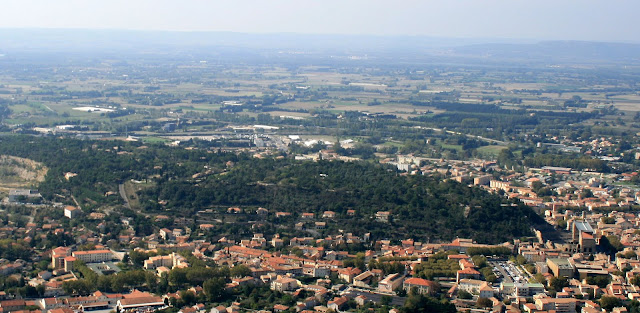


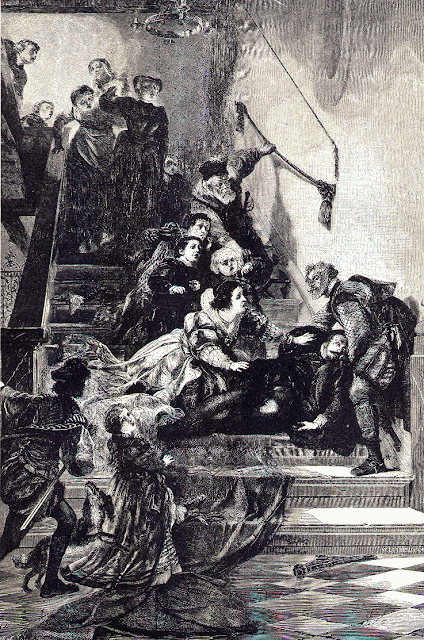





















































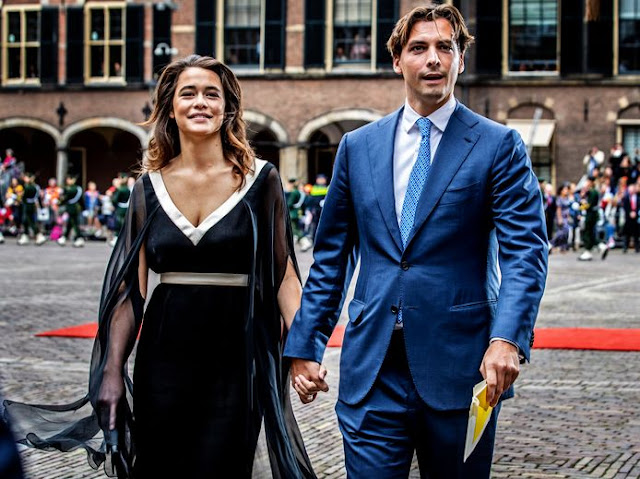























































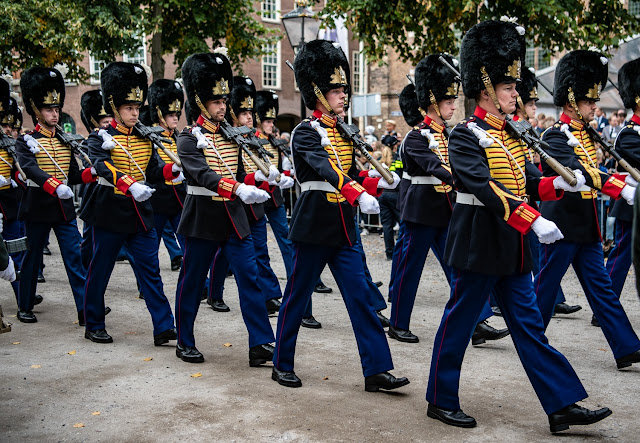
























































































































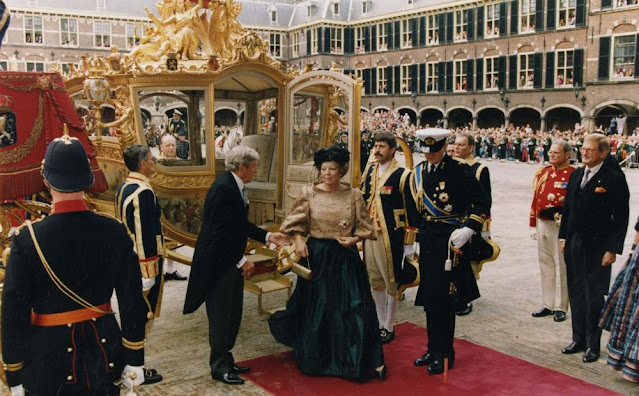






























































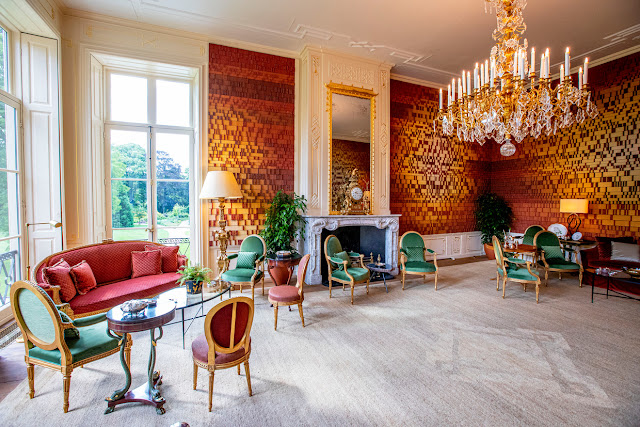
















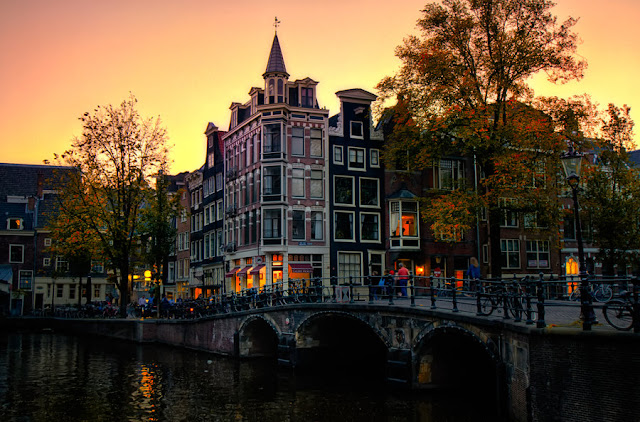
No comments:
Post a Comment
Don't be shy: leave your comments :)